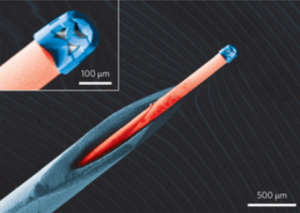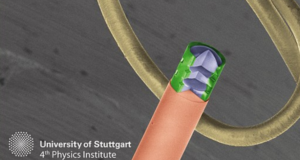 With the growing popularity of smartphones that have integrated digital cameras, camera technology has decreased in size dramatically over the last few years. But it has primarily been the electronics that have gotten smaller while the lens size has remained relatively stationary. The problem is that traditional manufacturing technology is simply incapable of shrinking the size of the lens down any further that it already has, so camera technology is incapable of being reduced in size much further. However, several modern 3D printing technologies are becoming precise enough to potentially manufacture highly complex three-dimensional structures at the micro-scale, which means that functional micro-cameras are a very real possibility.
With the growing popularity of smartphones that have integrated digital cameras, camera technology has decreased in size dramatically over the last few years. But it has primarily been the electronics that have gotten smaller while the lens size has remained relatively stationary. The problem is that traditional manufacturing technology is simply incapable of shrinking the size of the lens down any further that it already has, so camera technology is incapable of being reduced in size much further. However, several modern 3D printing technologies are becoming precise enough to potentially manufacture highly complex three-dimensional structures at the micro-scale, which means that functional micro-cameras are a very real possibility.
A group of German engineers at the University of Stuttgart led by Dr. Timo Gissibl have developed a process for creating a functional micro-camera that is the size of a grain of sand. A working camera this size could revolutionize medical science by allowing doctors to have a look inside a patient’s body, and even their organs, without requiring invasive surgeries. Of course a camera on that scale could also be considered quite a troubling development for the future of personal privacy and surveillance. While the micro-cameras could theoretically be injected into a person’s body with a syringe, allowing doctors unprecedented access to their patients bodies, the same cameras could also be used as virtually undetectable security or spy cameras.
“Current lens systems are restricted in size, shape and dimensions by limitations of manufacturing. Multi-lens elements with non-spherical shapes are required for high optical performance and to correct for aberrations when imaging at wide angles and large fields. Here we present a novel concept in optics that overcomes all of the aforementioned difficulties and opens the new field of 3D printed micro- and nano-optics with complex lens designs,” wrote the researchers in their paper recently published in Nature Photonics.
Once the team of German researchers developed the concept for the micro-camera it only took them a couple of hours to design, 3D print and test their first tiny lenses. According to the team, the finished product produced a high level of optical performance despite its diminutive size. The triple lens optical head is only about 100 micrometers (0.1 mm or 0.004 inches) wide, and with the entire micro-camera casing only 120 micrometers wide. Currently it is capable of focusing on images as far away as 3.0 mm, and it will relay images along the attached 1.7 meter (5.6 foot) optical fiber cord that is about twice as thick as a human hair. The camera and cord is so small that it can be injected into the human body with a standard syringe needle.
The micro-lenses were 3D printed using a femtosecond two-photon direct laser writing process that is similar to stereolithography, simply at a much smaller scale. This advanced additive manufacturing process allowed the highly functional lenses to be manufactured at the micro-scale. The process used to manufacture the 3D printed compound lens is highly versatile, so the lenses can be 3D printed on image sensors or directly onto the electronics used in digital cameras. It may even be possible to further reduce the size of the lens, allowing for the internal examination of microscopic structures. These micro-cameras can be used for medical purposes as well as a wide range of industrial applications.
You can learn more about this amazing 3D printed micro-camera by downloading the entire “Two-Photon Direct Laser Writing of Ultracompact Multi-Lens Objectives” paper from Nature Photonics. The paper’s authors include Timo Gissibl, Simon Thiele, Alois Herkommer and Harald Giessen. Discuss further in the 3D Printed Camera Lenses forum over at 3DPB.com.
Subscribe to Our Email Newsletter
Stay up-to-date on all the latest news from the 3D printing industry and receive information and offers from third party vendors.
You May Also Like
Precision at the Microscale: UK Researchers Advance Medical Devices with BMF’s 3D Printing Tech
University of Nottingham researchers are using Boston Micro Fabrication‘s (BMF) 3D printing technology to develop medical devices that improve compatibility with human tissue. Funded by a UK grant, this project...
3D Printing Webinar and Event Roundup: April 21, 2024
It’s another busy week of webinars and events, starting with Hannover Messe in Germany and continuing with Metalcasting Congress, Chinaplas, TechBlick’s Innovation Festival, and more. Stratasys continues its advanced training...
3D Printing Webinar and Event Roundup: March 17, 2024
It’s another busy week of webinars and events, including SALMED 2024 and AM Forum in Berlin. Stratasys continues its in-person training and is offering two webinars, ASTM is holding a...
3D Printed Micro Antenna is 15% Smaller and 6X Lighter
Horizon Microtechnologies has achieved success in creating a high-frequency D-Band horn antenna through micro 3D printing. However, this achievement did not rely solely on 3D printing; it involved a combination...
































